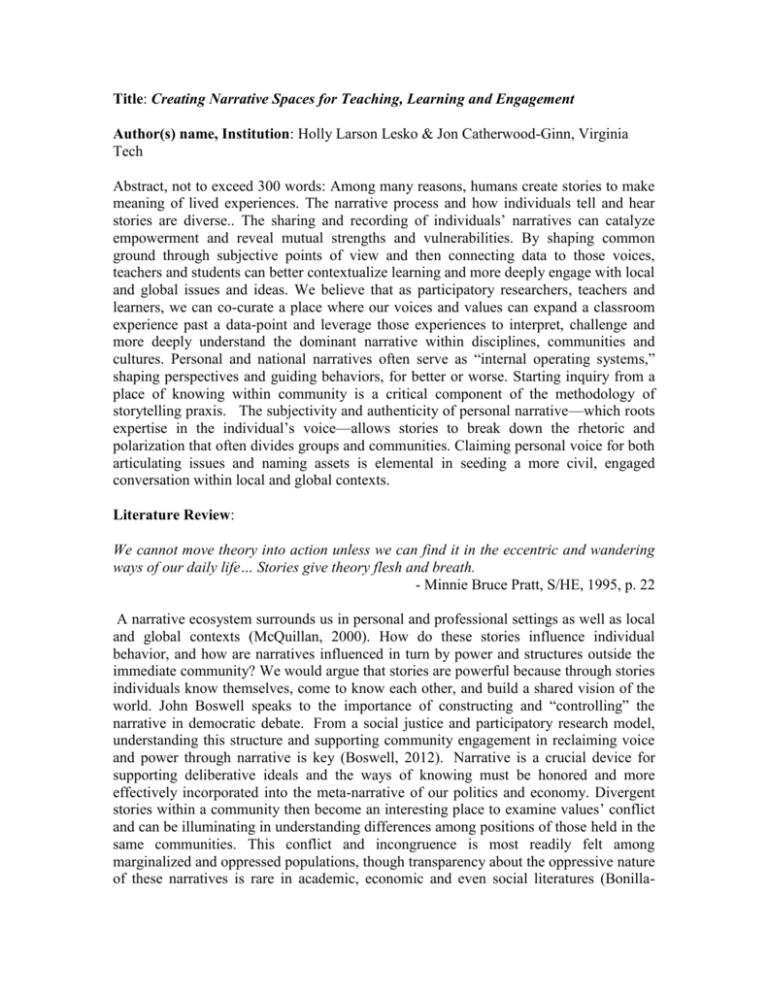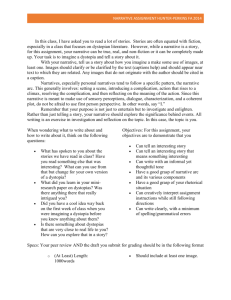2-page proposal file
advertisement

Title: Creating Narrative Spaces for Teaching, Learning and Engagement Author(s) name, Institution: Holly Larson Lesko & Jon Catherwood-Ginn, Virginia Tech Abstract, not to exceed 300 words: Among many reasons, humans create stories to make meaning of lived experiences. The narrative process and how individuals tell and hear stories are diverse.. The sharing and recording of individuals’ narratives can catalyze empowerment and reveal mutual strengths and vulnerabilities. By shaping common ground through subjective points of view and then connecting data to those voices, teachers and students can better contextualize learning and more deeply engage with local and global issues and ideas. We believe that as participatory researchers, teachers and learners, we can co-curate a place where our voices and values can expand a classroom experience past a data-point and leverage those experiences to interpret, challenge and more deeply understand the dominant narrative within disciplines, communities and cultures. Personal and national narratives often serve as “internal operating systems,” shaping perspectives and guiding behaviors, for better or worse. Starting inquiry from a place of knowing within community is a critical component of the methodology of storytelling praxis. The subjectivity and authenticity of personal narrative—which roots expertise in the individual’s voice—allows stories to break down the rhetoric and polarization that often divides groups and communities. Claiming personal voice for both articulating issues and naming assets is elemental in seeding a more civil, engaged conversation within local and global contexts. Literature Review: We cannot move theory into action unless we can find it in the eccentric and wandering ways of our daily life… Stories give theory flesh and breath. - Minnie Bruce Pratt, S/HE, 1995, p. 22 A narrative ecosystem surrounds us in personal and professional settings as well as local and global contexts (McQuillan, 2000). How do these stories influence individual behavior, and how are narratives influenced in turn by power and structures outside the immediate community? We would argue that stories are powerful because through stories individuals know themselves, come to know each other, and build a shared vision of the world. John Boswell speaks to the importance of constructing and “controlling” the narrative in democratic debate. From a social justice and participatory research model, understanding this structure and supporting community engagement in reclaiming voice and power through narrative is key (Boswell, 2012). Narrative is a crucial device for supporting deliberative ideals and the ways of knowing must be honored and more effectively incorporated into the meta-narrative of our politics and economy. Divergent stories within a community then become an interesting place to examine values’ conflict and can be illuminating in understanding differences among positions of those held in the same communities. This conflict and incongruence is most readily felt among marginalized and oppressed populations, though transparency about the oppressive nature of these narratives is rare in academic, economic and even social literatures (Bonilla- Silva et al, 2008). The narrative praxis is rooted in dialogic inquiry within a participatory research framework. Engagement in this form of individual, classroom and community collaboration is grounded in the ideals of shared knowledge creation within a belief that expertise is found in all learners and teachers. Thus, learning is not a separate and independent activity, but an integral aspect of participation in any community of practice. Nor is learning dependent on teaching in the most traditional sense of that term. The most serious problem is in treating knowledge as some thing that people possess. Knowledge is created and recreated between people, as they bring their personal experience and information derived from other sources to bear on solving a particular problem. (Wells 1999). Goals and objectives for the practice session (what should the participants know or be able to do after the session?): Facilitators will offer context and methods for using storytelling in the classroom to develop community, engage students, foster peer learning and teaching, create safe spaces for engaging in controversial and potentially divisive topics and support reflexive practice. Description of practice to be exemplified: In practical terms, this session will include a participatory storytelling component, based on Roadside Theatre’s Story Circle Guidelines. The roots of this practice reside in many places and peoples - most immediately in the work of theater artist/community organizer John O’Neal who developed a story-circle practice in the 1960s with the Student Non-Violent Coordinating Committee (SNCC) and his allied Free Southern Theatre, and refined his practice through his subsequent company, Junebug Productions. Through guided inquiry, the facilitators will lead participants in story circles with subsequent dialogue about the revelation of shared values or concerns, divergent perspectives, and emerging perspectives on others’ view of the world. Additionally, examples of captured narrative work (video and audio) will be shared along with a brief overview of the tools and process used to create these digital artifacts. Discussion: The narrative process honors the truth that each story, each person, brings wisdom to the whole. By starting from a place of honoring self-knowing, we find that learning and education occurs without fear of self-loss. We must continue to evolve our notions of Storytelling like other behaviors, to ensure our survival. Narrative is a place where indigenous and marginalized populations can anchor or challenges widely accepted data/information, rather than have others tell their story. We are all storytellers and gatherers. The key to building community in this context is to honor the individual narrative and provide context and space for sharing and knowing each other in this powerful medium and method. The classroom is an idealized place to practice this important community engagement and learning tool. References: Bonilla-Silva, Eduardo and Tukufu Zuberi, 2008; “Toward a Definition of White Logic and White Methods.” pp. 3-27 in White Logic, White Methods: Racism and Methodology, edited by Tukufu Zuberi and Eduardo Bonilla-Silva. Lanham, MD: Rowman & Littlefield Publishers. Boswell, John, 2012. “Why and How Narrative Matters in Deliberative Systems.” Political Studies, Political Studies Association. Chase, Susan E. 2005. “Narrative Inquiry: Multiple Lenses, Approaches, Voices.” pp. 651- 679 in Handbook of Qualitative Research, 3rd edition, edited by Norman K. Denzin & Yvonna S. Lincoln. Thousand Oaks, CA: Sage. Cook, Samuel R., 2009. “The Collaborative Power Struggle.” Collaborative Anthropologies 2: 109-114. The Narrative Reader, edited by Martin McQuillan. London and New York. Routledge, 2000. Pratt, M.B. 1995. S/HE. Ithaca, NY: Firebrand Books. Rappaport, Julian. 1995. “Empowerment Meets Narrative: Listening to Stories and Creating Settings.” pp. 795-807 in American Journal of Community Psychology, Vol. 23, No. 5. Roadside Theater. “Story Circle Guidelines.” roadside.org. http://roadside.org/asset/story-circle-guidelines. May 1, 2014. Salzer, M. S., 1994. Seeing the picture in our heads: Narrative and trait adjective stereotype research methods. Unpublished doctoral dissertation, University of Illinois at Urbana-Champaign. Wells, George, 1999. Dialogic Inquiry: Towards a Sociocultural Practices and Theory of Education. Cambridge: Cambridge University Press.








